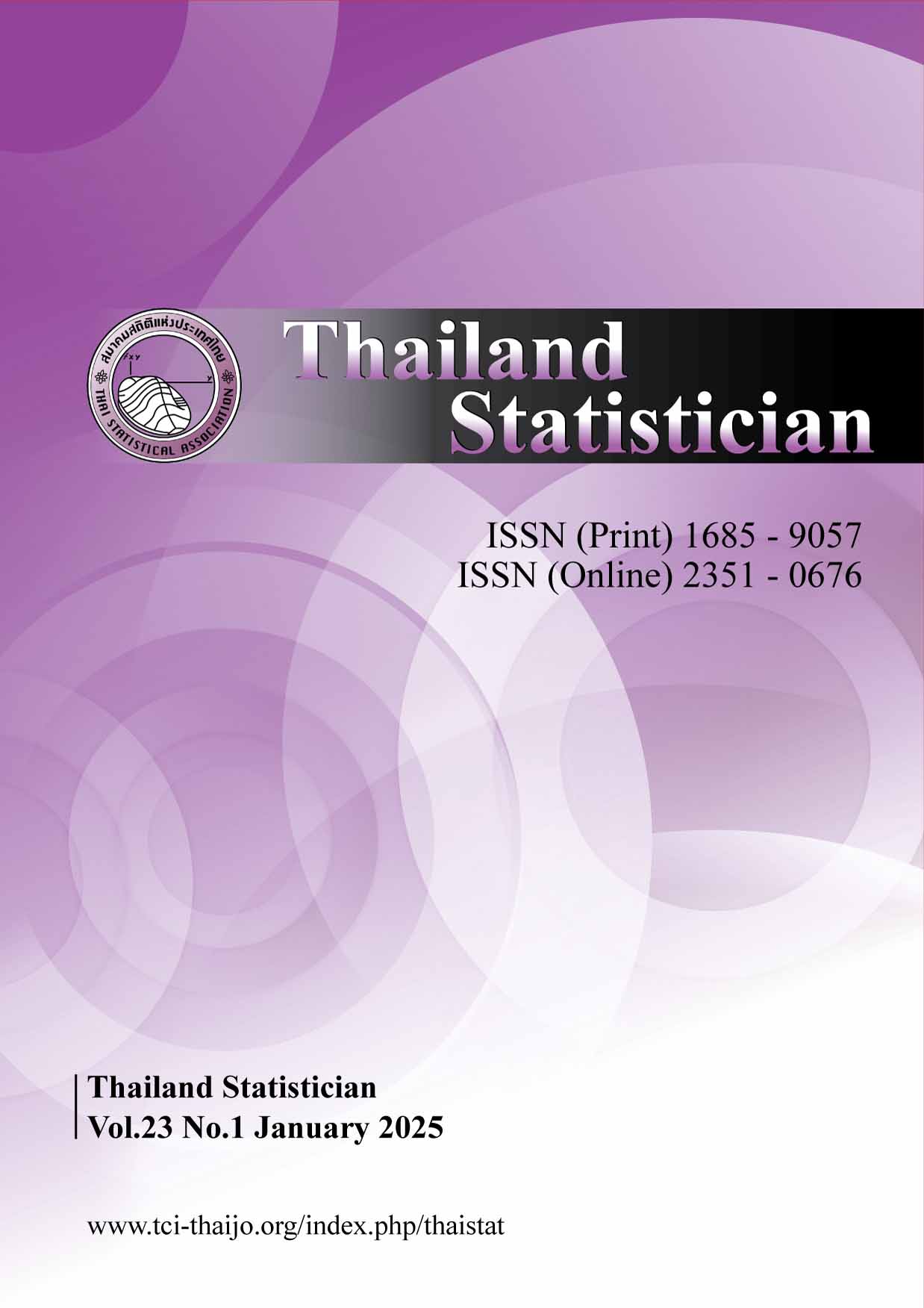A Study on Bivariate Inverse Topp-Leone Model to Counter Heterogeneous Data: Properties, Dependence Studies, Classical and Bayesian Estimation
Keywords:
Bivariate continuous model, copula, dependence, FGM, modeling, inference, inverse Topp-Leone, Bayesian, MCMCAbstract
In probability and statistics, reliable modeling of bivariate continuous characteristics remains a real insurmountable consideration. During the analysis of bivariate data, we have to deal with heterogeneity that is present in data. Therefore, for dealing with such a scenario, we investigate a novel technique based on a Farlie-Gumbel-Morgenstern (FGM) copula and the inverse Topp-Leone (ITL) model in this study. The idea is to use the oscillating functionalities of the FGM copula and the flexibility of the ITL model to propose a serious bivariate solution for the modeling of bivariate lifetime phenomena to counter the heterogeneity present in data. Both theory and practice are developed. In particular, we determine the main functions related to the model, like the cumulative model function, probability density function, and various useful dependence measures for bivariate modeling. The model parameters are estimated using the maximum likelihood method and Bayesian framework of the Markov Chain Monte Carlo (MCMC) methodology. Following that, model comparison methods are used to compare models. To explain the findings and show that better models are recommended, the famous Drought and Burr data sets are used.
References
Abulebda M, Pathak AK, Pandey A, Tyagi S. On a bivariate XGamma distribution derived from Copula. Statistica. 2022 Jul 12; 82(1):15-40.
Abulebda M, Pandey A, Tyagi S. On bivariate inverse Lindley distribution derived from Copula. Thailand Statistician. 2023 Mar 29; 21(2):291-304.
Alley W. The Palmer drought severity index: limitations and assumptions. J Clim Appl Meteorol. 1984; 23:1100-1109.
Amblard C, Girard S. A new extension of bivariate FGM copulas. Metrika. 2009; 70(1): 1-17.
Bhattacharjee S, Misra SK. Some aging properties of Weibull models. Electron. J. Appl. Stat. Anal. 2016; 9(2): 297-307.
Chacko M, Mohan, R. Bayesian analysis of weibull distribution based on progressive Type-II censored competing risks data with binomial removals. Comput Stat. 2018; 34(4): 233-252.
Dasgupta, R. On the distribution of Burr with applications. Sankhya B. 2011; 73: 1-19.
Dolati A, Amini M, Mirhosseini SM. Dependence properties of bivariate distributions with proportional (reversed) hazards marginals. Metrika. 2014; 77(3): 333-347.
Eberly LE, Casella G. Estimating Bayesian credible intervals. J Stat Plan Inference. 2003; 112(1–2): 115–32. doi:10.1016/S0378-3758(02)00327-0.
Farlie DJ. The performance of some correlation coefficients for a general bivariate distribution. Biometrika. 1960; 47(3/4): 307-323.
Gumbel EJ. Statistics of extremes. Columbia university press; 1958.
Gumbel EJ. Bivariate exponential distributions. J Am Stat Assoc. 1960; 55(292): 698-707.
Hassan AS, Elgarhy M, Ragab R. Statistical properties and estimation of inverted Topp-Leone distribution. J. Stat. Appl. Probab. 2020; 9(2): 319-331.
Ibrahim JG, Ming-Hui C, Sinha, D. Bayesian Survival Analysis. Springer, Verlag; 2001.
Joe H. Multivariate models and multivariate dependence concepts. New York: Chapman and Hall; 1997.
Joe H. Dependence modeling with copulas New York: CRC press; 2014.
Johnson NL, Kotz S, Balakrishnan N. Continuous univariate distributions. New York: John Wiley & Sons; 1994.
Johnson NL, Kotz S. A vector multivariate hazard rate. J Multivar Anal. 1975; 5(1): 53-66.
Kundu D, Gupta AK. On bivariate inverse Weibull distribution. Braz J Probab Stat. 2017; 31(2): 275-302.
Kundu D, Gupta, RD. Bivariate generalized exponential distribution. J Multivar Anal. 2009; 100(4): 581-593.
Marshall AW, Olkin I. A generalized bivariate exponential distribution. J Appl Probab. 1967; 4(2): 291-302.
Mirhosseini SM, Amini M, Kundu D, Dolati A. On a new absolutely continuous bivariate generalized exponential distribution. Stat Methods Appl. 2015; 24(1): 6183.
Morgenstern D. Einfache beispiele zweidimensionaler verteilungen. Mitteilingsblatt fur Mathematische Statistik. 1956; 8: 234-235.
Nadarajah S. A bivariate Pareto model for drought. Stoch Environ Res Risk Assess. 2009; 23(6): 811-822.
Nelsen RB. An introduction to copulas. Springer series in statistics; 2006.
Norstrom JG. The use of precautionary loss functions in risk analysis. IEEE Trans Reliab. 1996; 45(3): 400-403.
Pathak AK, Vellaisamy P. Various measures of dependence of a new asymmetric generalized Farlie–Gumbel–Morgenstern copulas. Commun Stat. - Theory Methods. 2016; 45(18): 5299-5317.
Rinne H. The Weibull distribution: a handbook. New York: CRC press; 2008.
Sankaran PG, Nair NU. A bivariate Pareto model and its applications to reliability. Nav Res Logist. 1993; 40(7): 1013-1020.
Santos CA, Achcar JA. A Bayesian analysis for multivariate survival data in the presence of covariates. J Stat Theory Appl. 2010; 9: 233-53.
Sarhan AM, Hamilton DC, Smith B, Kundu D. The bivariate generalized linear failure rate distribution and its multivariate extension. Comput Stat Data Anal. 2011; 55(1): 644-654.
Sarhan AM, Kundu D. Generalized linear failure rate distribution. Commun Stat. - Theory Methods. 2009; 38(5): 642-660.
Sen S, Chandra N, Maiti SS. On properties and applications of a two-parameter XGamma distribution. J Stat Theory Appl. 2018; 17(4): 674-685.
Sklar M. Fonctions de repartition an dimensions et leurs marges. Publ Inst Statist Univ Paris. 1959; 8: 229-231.
Topp CW, Leone FC. A family of J-shaped frequency functions. J Am Stat Assoc. 1955; 50(269): 209-219.
Tyagi S, Agiwal V, Kumar S, Chesneau C. Theory and practice of a bivariate trigonometric Burr XII distribution. Afrika Matematika. 2023; 34(3): 49.
Tyagi S. On bivariate Teissier model using Copula: dependence properties, and case studies. Int J Syst Assur Eng Manag. 2024; 15(6): 2483-2499.
Yevjevich V. An objective approach to definitions and investigations of continental hydrologic droughts. Hydrologic paper no. 23. Colorado State University; 1967.
Downloads
Published
How to Cite
Issue
Section
License

This work is licensed under a Creative Commons Attribution-NonCommercial-NoDerivatives 4.0 International License.




